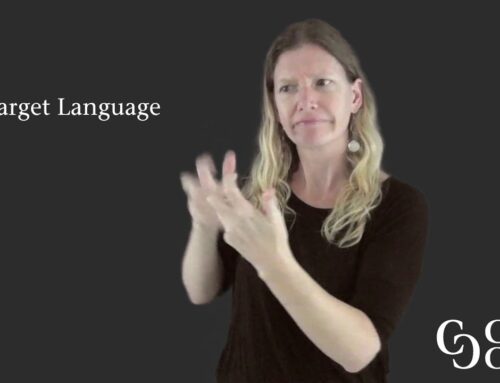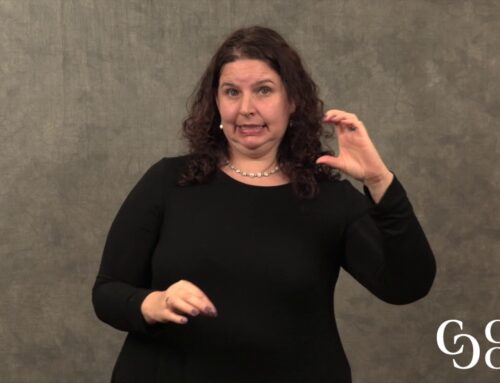Competencies Addressed: Simultaneous interpreting
Time Required for Activity: 45-60 mins
Objective:
Interpreters will:
- Produce an interpretation that is equivalent to the academic register used in the source video.
In this English address, an actor delivers an an English version of the original presentation by Laurene Gallimore who first introduces herself and provides some of her relevant background. Then she shares her perspective on the state of Deaf education and some informal research she conducted. This activity allows you to work from an English translation as a source and then compare your work to the original presentation.
The original video was taken from Language Use in ASL, created by the Region X Interpreter Education Center at Western Oregon State College.
Start by opening the Step 1 Toggle
Spoken English translation
Preparation
In this video, the presenter’s register is more formal and academic than conversational. Consider the features of ASL presentations of the same type. What makes them sound more formal and less conversational? Is it words? Sentence structures? Both?
You can learn more about formal and academic discourse in ASL by watching this video:
Simultaneously Interpret the Video into ASL
Interpret the Deaf Education video cold, without watching it first, and record your work.
Prepare for the interpretation by getting centered. For example, you may want to take a deep breath, get calm and determined and ready to do your best. Visualize yourself demonstrating the skills you are working on. You can do it!
Whenever possible, you are encouraged to interpret for a live person. When you work with real people, you are able to adjust your interpretation in real time based on cues you get from the person you are working with and do your best work. If you are not able to interpret for a live person, visualize a hearing individual with whom you are comfortable. In your mind, your goal is to make sure that this person appreciates the story as much as someone who uses the same language as the speaker and may want to meet the presenter.
View English source video and interpret. (Video will open in pop-up window.)
Get Feedback
Whether you were able to interpret for a live person or not, you are encouraged to ask for feedback form a hearing person (friend or mentor). Either show your listener your recorded work or request feedback or upon completion of the live interpretation.
Ask your viewer to look for specific features, especially about the features you are working on for this interpretation, rather than just overall feedback. Some questions you can ask are:
- Where in the interpretation did you feel confused?
- Could you tell who was doing what?
- Were there terms that weren’t clear?
- Were enough facial expressions/vocal inflection used?
- Were classifiers used/interpreted correctly?
You can also ask comprehension questions specific to the interpretation, or ask your viewer to summarize the information from the interpretation to find out if your message was clear.
Step Four: Assess your work
This step consists of several parts.
Assess your ASL:
- First, to accurately assess your work, watch your recording and transcribe your ASL interpretation. If you have access to GoReact, you can also use this tool and use the markers to code your work.
- Next, translate your interpreting work into numerical data that you can use to assess improvement, first get some numbers to use in assessing your interpretation. By doing so, you can focus your attention on increasing the frequency of the patterns that you want, rather than reducing those that you don’t. You can assess your improvement in clarity, grammatical accuracy, and use of unnecessary filler words (or any other skill). To do so, first count the number of total English sentences in the transcription you created of your work.
First, count the number of sentences that meet the goals of this activity. Count the number of sentences that:
- Look formal and academic, rather than conversational
Now, count the number of sentences that are:
- Clear and accurate
- Look like natural ASL
- Grammatically correct
- Start with a sign other than some type of hesitation
For each category, you can determine the percentage of successful sentences by dividing the number of successful sentences by the number of total sentences. For example, if there are 50 sentences in the interpretation rendered, and 40 of them are clear and accurate, your percentage for the category is 80%. The percentage will give you a goal to exceed in subsequent English to ASL interpreting work.
Fouls and penalties: While you are assessing the percentage of successful sentences in your interpretation, consider that there are certain features of less successful interpretations that are more severe than others. These are significantly disruptive or deceptive. These can be thought of as fouls in sports, and efforts should be made to eliminate them whenever possible to avoid penalties. Examples are:
- Failure to clearly articulate in a way that is easy for the audience to comprehend
- Nonsensical sentences, sentence fragments, and random words or phrases
- Apologies, announcements that you missed what was signed, self-criticisms, or swearing
- If you had difficulty understanding the source video, re-watch it as many times as you need to fully comprehend the content.
- Finally, view the spoken English translation that is provided.View the signed ASL original presentation. (Video will open in pop-up window.)In the translation, look for the key features you are working on for this assignment to see how they are produced. Consider the following questions when watching the ASL original:
- What terms does the signer use?
- How are sentences structured?
- How is affect conveyed—through facial expression? Modulation of signs?
- How are conversations portrayed?
- How is culture-specific information conveyed?
Step Five: Re-do interpretation and Re-assess
Now that you have reviewed your work and studied a spoken English translation, try the interpretation again and incorporate as many of the desired features from the translation that you can. Don’t forget to record your work.
View English source video and interpret. (Video will open in pop-up window.)
Finally, review your work one last time. Were you able to incorporate features that resulted in an improved version? If you can do it even better, try it again. Repeat until you are satisfied with your work.
For continued skill development with register in English, see the other activity in this series:
Source Video
Getting Started
Getting Started
To begin, open the Step 1 toggle.





